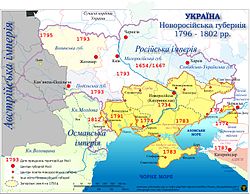Expansion of Russia (1500–1800)
The steppe and forest-steppe of Ukraine and southern Russia, traditionally held by pastoral nomads, provided agricultural opportunities.
[1] Its plains, which are nestled between the Baltic and Black seas, offer a wealth of natural resources and room for expansion, especially with easy access to river routes.
The Eurasian Steppe first appears in written history about 600 BC with the founding of Greek colonies along the north coast of the Black Sea.
They adopted the local language and formed a state (Kievan Rus) which gradually broke up into a set of linked principalities.
In its early years, the state paid the Khazars tribute but by tenth century, the Kievan prince Sviatoslav overthrew their rule and ended their empire.
[2] He also caused the fall of the Bulgarian empire and conquered numerous East Slavic tribes, the Alans, and the Volga Bulgars.
Through alliances and conquest, in competition with the Principality of Moscow, the Grand Duchy of Lithuania eventually gained control of vast expanses of the western and southern portions of the former Kievan Rus'.
By the 16th century, Polish claims extended east of the Dnieper to a point south of Moscow, although the area was thinly settled and barely administered.
Brian L. Davis [5] suggests that Moscow's ultimate advantage was the comparative absence of restraints on its ability to command resources for war.
Slavic settlers preferred the river valleys because of better protection, transportation, firewood, game, and soil (steppe grass can be quite difficult to plow).
During the Russo-Lithuanian Wars (1492–1522), Moscow took the northeast part of Lithuania, including the Upper Oka Principalities, Smolensk (1514,120s,250w), Novgorod Seversky (1503,400s,400w), and Chernihiv(1503,480s,300w).
With the removal of the Great Horde as a buffer state, Crimea became the main enemy, and work was begun to strengthen the Oka defenses.
Crimea: In 1556, Moscow, in alliance with Dmytro Vyshnevetsky of the Zaporozhian, Cossacks attempted several raids on the Black Sea coast.
To the south, forts were built along the main Tatar raiding trail at Elets (1592:350s,50e), Voronezh (1586:450s,100e), Belgorod (1593:575s,75w), and Stary Oskol (1593:490s).
Rangers: The practice of sending out long-range patrols appears to have started in the early 16th century at Putivl near the upper Oka.
A ranger patrol usually consisted of a captain and a few dozen men who covered great distances with no fixed route.
The ranger patrols in the south gave early warning while the starozhas detected most penetrations and sent word north to the garrisons and defense lines.
Growing military presence in the south reduced the Tatar threat and increased the number of peasants who were willing to try their luck on the frontier.
A proper history of Russia's southward expansion would need a table showing population by region and decade, but such numbers do not seem to be available.
The war also saw the first use of foreign- formation troops (European mercenary officers and paid soldiers using Dutch-style drill) that were to be important for the next 75 years.
At the start of the war, Russia could field about 100,000 men: 27,000 traditional servicemen, 33,000 musketeers, 4,000 artillerymen, 11,000 Cossacks, and about 20,000 Tatar irregulars (up from 35,000 in 1500).
Where the Don turns east (about 500s) it ran southwest to Ostrogozhsk (1652,525s,75e) then west and slightly south through Userdsk (1637), Novy Oskol (550s,) Ioblonov, Korocha (1638), Belgorod (1596,575s,50w), Kotmyzsk to Okhtyrka (1641, a Polish foundation:600s,150w).
In 1636 a wall was built east from Kozlov at the north end of the Belgorod Line that effectively blocked the Nogai Road.
The Trans-Kama Line (1652–57) ran eastward from the Volga at Bely Yar below Simbirsk to Menzelinsk (1586 975e) on a southern tributary of the Kama.
From about 1637, there were rebellions in the eastern lands which led to a movement of population into Russian territory south of the Belgorod Line (Sloboda Ukraine).
By the Treaty of Andrusovo in 1667, Russia acquired Smolensk and Chernihiv and nominal rule over the lands east of the Dnieper, including Kiev.
During this period, Doroshenko allied with the Turks, bringing Ottoman armies onto the steppe for the second, and final time (Russo-Turkish War (1676–1681).
From Userdsk west of the southeast corner of the Belgorod Line, it ran southwest to Valuyki (1593,625s,60s) and then south down the Oskol River to its juncture with the Donets (750s) below the old site of Tsarev-Borisov which was apparently reestablished.
The Russo-Turkish War (1686–1700): After the Turkish failure to take Vienna in 1683, Russia joined Austria, Poland, and Venice in the Holy League (1684) to drive the Turks southward.
The lesser forts quickly surrendered, but Kazy-Kermen was too damaged to hold and the main Russian force withdrew up the Dnieper to protect the Left Bank.















